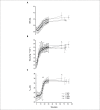Thermoregulation in Hypertensive Rats during Exercise: Effects of Physical Training
- PMID: 30892385
- PMCID: PMC6555570
- DOI: 10.5935/abc.20190050
Thermoregulation in Hypertensive Rats during Exercise: Effects of Physical Training
Abstract
Background: Spontaneously hypertensive rats (SHR) show deficit in thermal balance during physical exercise.
Objective: To assess the effects of low-intensity physical exercise training on thermal balance of hypertensive rats undergoing an acute exercise protocol.
Methods: Sixteen-week-old male Wistar rats and SHR were allocated into four groups: control Wistar rats (C-WIS), trained Wistar (T-WIS), control SHR (C-SHR) and trained SHR (T-SHR). Treadmill exercise training was performed for 12 weeks. Blood pressure, resting heart rate and total exercise time was measured before and after the physical exercise program. After the exercise program, a temperature sensor was implanted in the abdominal cavity, and the animals subjected to an acute exercise protocol, during which internal body temperature, tail skin temperature and oxygen consumption until fatigue were continuously recorded. Mechanical efficiency (ME), work, heat dissipation threshold and sensitivity were calculated. Statistical significance was set at 5%.
Results: Physical training and hypertension had no effect on thermal balance during physical exercise. Compared with C-WIS, the T-WIS group showed higher heat production, which was counterbalanced by higher heat dissipation. Hypertensive rats showed lower ME than normotensive rats, which was not reversed by the physical training.
Conclusion: Low-intensity physical training did not affect thermal balance in SHR subjected to acute exercise.
Conflict of interest statement
No potential conflict of interest relevant to this article was reported.
Figures




Comment in
-
Control of Body Temperature during Physical Exercise.Arq Bras Cardiol. 2019 Jun 6;112(5):543-544. doi: 10.5935/abc.20190081. Arq Bras Cardiol. 2019. PMID: 31188960 Free PMC article. No abstract available.
Similar articles
-
Effects of moderate-continuous and high-intensity interval aerobic training on cardiac function of spontaneously hypertensive rats.Exp Biol Med (Maywood). 2022 Sep;247(18):1691-1700. doi: 10.1177/15353702221110823. Epub 2022 Jul 26. Exp Biol Med (Maywood). 2022. PMID: 35880885 Free PMC article.
-
High-intensity intermittent training is as effective as moderate continuous training, and not deleterious, in cardiomyocyte remodeling of hypertensive rats.J Appl Physiol (1985). 2019 Apr 1;126(4):903-915. doi: 10.1152/japplphysiol.00131.2018. Epub 2019 Jan 31. J Appl Physiol (1985). 2019. PMID: 30702976
-
Exercise training increases baroreceptor gain sensitivity in normal and hypertensive rats.Hypertension. 2000 Dec;36(6):1018-22. doi: 10.1161/01.hyp.36.6.1018. Hypertension. 2000. PMID: 11116118
-
Low-intensity exercise training decreases cardiac output and hypertension in spontaneously hypertensive rats.Am J Physiol. 1997 Dec;273(6):H2627-31. doi: 10.1152/ajpheart.1997.273.6.H2627. Am J Physiol. 1997. PMID: 9435596
-
High calcium diet reduces blood pressure in exercised and nonexercised hypertensive rats.Am J Hypertens. 1996 Feb;9(2):144-56. doi: 10.1016/0895-7061(95)00333-9. Am J Hypertens. 1996. PMID: 8924264 Review.
Cited by
-
Impaired thermoregulation in spontaneously hypertensive rats during physical exercise is related to reduced hypothalamic neuronal activation.Pflugers Arch. 2020 Dec;472(12):1757-1768. doi: 10.1007/s00424-020-02474-2. Epub 2020 Oct 10. Pflugers Arch. 2020. PMID: 33040159
-
Core body temperatures of rats subjected to treadmill exercise to fatigue or exhaustion: The journal Temperature toolbox.Temperature (Austin). 2022 Sep 1;10(3):287-312. doi: 10.1080/23328940.2022.2115274. eCollection 2023. Temperature (Austin). 2022. PMID: 37554383 Free PMC article.
-
Chitosan-PEG Gels Loaded with Jatropha mollissima (Pohl) Baill. Ethanolic Extract: An Efficient and Effective Biomaterial in Hemorrhage Control.Pharmaceuticals (Basel). 2023 Oct 3;16(10):1399. doi: 10.3390/ph16101399. Pharmaceuticals (Basel). 2023. PMID: 37895870 Free PMC article.
-
Control of Body Temperature during Physical Exercise.Arq Bras Cardiol. 2019 Jun 6;112(5):543-544. doi: 10.5935/abc.20190081. Arq Bras Cardiol. 2019. PMID: 31188960 Free PMC article. No abstract available.
References
-
- Webb P. The physiology of heat regulation. Pt 2Am J Physiol. 1995;268(4):R838–R850. - PubMed
-
- Gleeson M. Temperature regulation during exercise. Int J Sports Med. 1998;19(Suppl 2):S96–S99. - PubMed
-
- Fuller A, Carter RN, Mitchell D. Brain and abdominal temperatures at fatigue in rats exercising in the heat. J Appl Physiol. 1998;84(3):877–883. - PubMed
-
- Chobanian AV, Bakris GL, Black HR, Cushman WC, Green LA, Izzo JL Jr, et al. The Seventh Report of the Joint National Committee on Prevention, Detection, Evaluation, and Treatment of High Blood Pressure: the JNC 7 report. JAMA. 2003;289(19):2560–2572. - PubMed
-
- Trippodo NC, Frohlich ED. Similarities of genetic (spontaneous) hypertension. Man and rat. Circ Res. 1981;48(3):309–319. - PubMed
Publication types
MeSH terms
LinkOut - more resources
Full Text Sources
Medical

